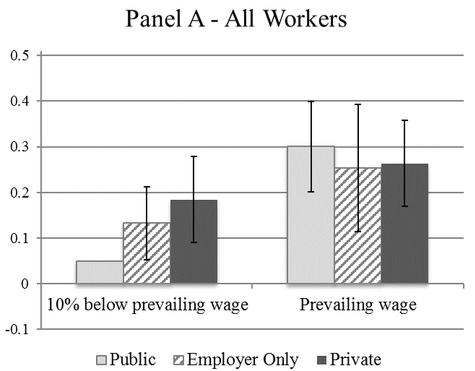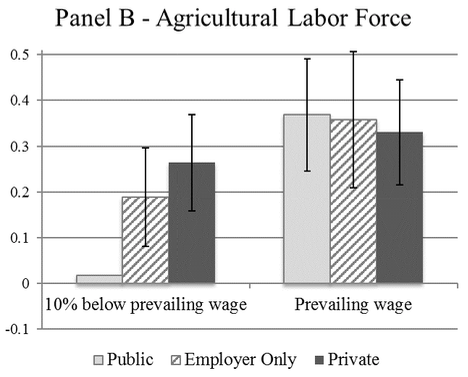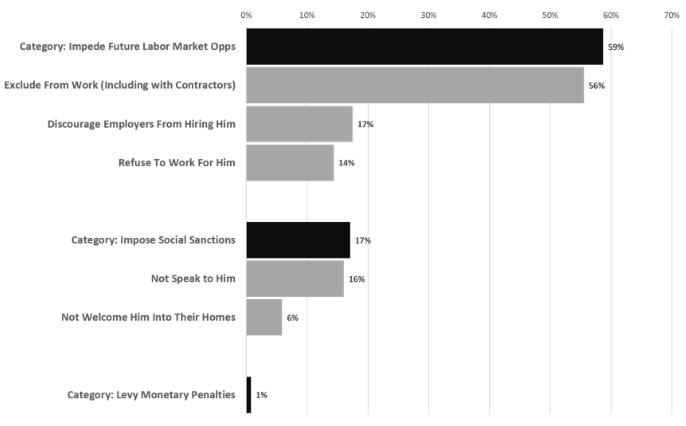
Social norms help sustain wage floors with workers taking jobs at wage cuts in private, but rejecting them in public due to fear of sanctions
Literatures in economics, psychology, political science, and sociology document that norms embody a shared understanding of what is acceptable (e.g. Fehr and Schurtenberger 2018, Cialdini and Goldstein 2004, Crawford and Ostrom 1995, Bendor and Swistak 2001). Norms can therefore enable collective behaviour among a decentralised group of individuals, even without explicit coordination or formal institutions.
This mechanism may guide group behaviours in any setting with meaningful social interaction. Labour markets are therefore a particularly relevant domain with most labour arrangements involving repeated inter-personal interaction among workers. Consistent with this, collective behaviours – mass walkouts with foregone wages, punishment of rate busters, and productivity compression – have been documented across history and contexts, even without formal unions (Clark 1984, Clark 1987). Social norms could help sustain such behaviour.
Enforcing collective action through social norms and social sanctions may be particularly relevant in poor countries, where local social networks are key in risk sharing and information diffusion. It is therefore more likely that norms arise and can be sustained effectively through the threat of punishment.
The experiment: Village-level variation in wages and observability
We test whether social norms shape aggregate labour supply in informal markets for casual daily agricultural labour in India (Breza et al. 2019). Despite a lack of formal coordination (Rosenzweig 1988), such labour markets have downwardly rigid wages and high lean-season unemployment.
We hypothesise that there is a norm against accepting jobs below the prevailing wage that dampens workers’ labour supply, and that workers are sanctioned for accepting wage cuts.
Do workers take up jobs at below the prevailing wage in public?
We partner with existing employers to make job offers for typical agricultural work to workers in their respective local labour markets (villages). Job offers follow usual hiring practices. In all offers, employers describe the task, before turning the conversation to the survey staff, who then reveal the wage rate.
Offers differ across villages:
- Wage rates: Jobs are offered either at the prevailing wage, or at 10% below the prevailing wage.
- Observability: Jobs are offered in the following ways:
- Public: On the street where neighbours (typically other workers) can overhear the offer.
- Employer only: Inside the worker’s home, out of earshot of co-villagers.
- Fully private: To isolate the employer’s role in maintaining this norm, in some villages we also ask the employer to step out of earshot during the wage offer.
Making job offers on the street or inside the home are both common practices.
Workers take pay cuts in private, but not in public
Our results are presented in Figure 1. Workers are considered to have accepted the job offer if they come to work for the full duration. At the prevailing wage, the average take-up rate for the job is 26%, with no detectable differences across the observability conditions. These prevailing-wage offers serve as placebo tests that observability alone does not affect job acceptance directly.
In contrast, take-up of job offers below the prevailing wage varies widely depending on whether the worker’s decision is observable to other workers. In private, his probability of take-up remains 18%. However, his willingness to accept a wage cut falls by 13.6 percentage points (78%) when the offer is observable to other workers. The presence of the employer (relative to complete privacy) does not significantly affect participants’ behaviour.
Figure 1


Notes: These figures graph take-up rates for the job offer under each of the six treatment arms. The take-up rate for the job is defined as attendance on the day of work. Panel A uses the entire sample (N=502 participants); Panel B restricts the sample to casual daily wage workers (N=363 participants), who report their primary or secondary occupation to be agricultural labour. All robust 90% CIs are constructed using standard errors (clustered at the village-level) from a test of the difference between the take-up rate in that treatment arm and the take-up rate for the public job offers at 10% below the prevailing wage.
The mechanism: Social sanctions
A rich body of laboratory observations suggests that when individuals are observed to violate a norm, others sanction them — even without any direct benefit (e.g. Gachter and Fehr 1999, Charness and Rabin 2002, Henrich et al. 2006). This accords with economic theories of how decentralised group behaviour is sustained over the long-term (Kandori 1992, Ellison 1994, MacLeod 2007).
We suggest that the observability effects from the main experiment stem, partly, from an attempt to avoid social censure. However, other reputational concerns could produce this pattern, such as shame from appearing destitute enough to accept a wage cut. We therefore show positive evidence that people sanction workers who violate the wage norm.
Do workers pay to punish those who take pay cuts?
We find that 80% of workers believe that accepting a job below the prevailing wage will result in sanctions, the most common of which are excluding the worker from future job opportunities, and not speaking to the worker. These findings are presented in Figure 2.
Figure 2

Notes: This figure graphs exit survey responses from 1,448 untreated holdout sample workers to the question: ``Suppose a worker accepts work at a rate lower than the prevailing wage. What will be the reaction of other workers?" Respondents were able to select as many responses as were applicable, and had the option of providing their own response. Responses were then aggregated into the categories shown in (a). In (b), the second question, ``If others try to convince him not to take the job, will he still do it?'' was asked of all respondents (regardless of their answer to the question in panel (a)).
We design a costly punishment game with a random subset of workers (‘players’) who were not offered jobs. Each player is paired with an anonymous worker (who was offered a job), and both are given endowments of 100 rupees. The player is told whether his partner accepted a job at the prevailing wage or at a pay cut. The player may spend his endowment to reduce his partner’s endowment, providing a mechanism to punish the worker at a cost to himself.
Workers pay to punish
37% of workers who accepted wage cuts are punished, and lose 37% of average daily earnings. In contrast, those who accept prevailing-wage jobs are not punished.
Social norms in aggregate: Ability to enforce norms matters for the labour market
Social norms may explain aggregate labour market behaviours. For example, wages are strongly downwardly rigid in such labour markets (Lewis 1954, Kaur 2019). Wages rise following positive productivity shocks, but do not fall after subsequent negative productivity shocks, resulting in high involuntary unemployment.
We provide one possible mechanism for this behaviour. In areas with less social cohesion, it may be harder to levy meaningful social sanctions, since workers are less socially integrated, potentially less reliant on each other (e.g. for leisure, marriage, jobs), and pass information less effectively through the network, making it harder to learn about and sanction deviations. Consequently, in such areas, wage floors may be more difficult to sustain. We find a strong correlation between a proxy for social cohesion – caste homogeneity (Munshi and Rosenzweig 2007, Mazzocco and Saini 2012, Rosenzweig and Stark 1989) – and wage rigidity.
But do workers gain?
Social norms in the labour market might help workers coordinate to exert greater market power, extracting surplus from employers. On the other hand, wage floors may increase wages for the average worker, at the cost of increased involuntary unemployment.
We conduct a back-of-the-envelope calculation of gains to worker surplus following Lee and Saez (2012). We find that, under admittedly strong assumptions, the market wage without the wage floor would be 7% lower, and, correspondingly, employment would be 7% higher. Workers benefit from the wage floor: workers’ surplus is 64% higher relative to the competitive equilibrium. Future research can explore collective behaviour among employers, and the distribution of surpluses among workers, to validate our assumptions.
Policy implications: Relevance to other settings
The forces we document could generalise beyond our specific setting. Our proposed mechanism hinges on two features: a clearly defined norm (with observable violations) and a mechanism to impose social sanctions (in order to prevent individual deviations).
The presence of cartel-like behaviour among decentralised individuals has been observed in a range of markets, from NASDAQ traders and real estate agents in the US (Christie and Schultz 1994, Hsieh and Moretti 2003), to local traders in poor countries (Bergquist 2018, Houde et al. 2018). In these instances, anecdotal evidence suggests that the observability of the norms and the social ties between agents help sustain this behaviour.
References
Bendor, J and P Swistak (2001), “The evolution of norms,” American Journal of Sociology 106: 1493–1545.
Bergquist, L (2018), “Pass-through, competition, and entry in agricultural markets: Experimental evidence from Kenya,” Working Paper.
Breza, E, S Kaur and N Krishnaswamy (2019), “Scabs: The Social suppression of labour supply,” NBER Working Paper 25880.
Charness, G and M Rabin (2002), “Understanding social preferences with simple tests,” The Quarterly Journal of Economics 117: 817–869.
Christie, W and P Schultz (1994), “Why do Nasdaq market makers avoid odd-eighth quotes?,” The Journal of Finance 49: 1813–1840.
Cialdini, R and N Goldstein (2004), “Social influence: Compliance and conformity,” Annual Review of Psychology 55: 591–621.
Clark, G (1984), “Authority and efficiency: The labour market and the managerial revolution of the late nineteenth century,” The Journal of Economic History 44: 1069–1083.
Clark, G (1987), “Why isn’t the whole world developed? Lessons from the cotton mills,” The Journal of Economic History 47: 141–173.
Crawford, S and E Ostrom (1995), “A grammar of institutions,” American Political Science Review 89: 582–600.
Ellison, G (1994), “Cooperation in the prisoner’s dilemma with anonymous random matching,” The Review of Economic Studies 61: 567–588.
Fehr, E and I Schurtenberger (2018), “Normative foundations of human cooperation,” Nature Human Behaviour 2: 458.
Gachter, S and E Fehr (1999), “Collective action as a social exchange,” Journal of Economic Behaviour & Organisation 39: 341 – 369.
Henrich, J, R McElreath, A Barr, J Ensminger, C Barrett, A Bolyanatz, J Cardenas, M Gurven, E Gwako, N Henrich, C Lesorogol, F Marlowe, D Tracer, and J Zicker (2006), “Costly punishment across human societies,” Science 312: 1767–1770.
Houde, JF, T Johnson, M Lipscomb and L Schechter (2018), “Measuring and addressing market power issues in the Desludging market in Senegal,” Working Paper.
Hsieh, CT and E Moretti (2003), “Can free entry be inefficient? Fixed commissions and social waste in the real estate industry”, Journal of Political Economy 111: 1076–1122.
Kandori, M (1992), “Social norms and community enforcement,” The Review of Economic Studies 59: 63–80.
Kaur, S (2019), “Nominal wage rigidity in village labour markets”, American Economic Review, (forthcoming).
Lee, D and E Saez (2012), “Optimal minimum wage policy in competitive labour markets,” Journal of Public Economics 96: 739–749.
Lewis, WA (1954), “Economic development with unlimited supplies of labour,” The Manchester School 22: 139–191.
MacLeod, WB (2007), “Can contract theory explain social preferences?”, The American Economic Review 97: 187–192.
Mazzocco, M and S Saini (2012), “Testing efficient risk sharing with heterogeneous risk preferences,” American Economic Review 102: 428–68.
Munshi, K and M Rosenzweig (2006), “Traditional institutions meet the modern world: Caste, gender, and schooling choice in a globalising economy,” American Economic Review 96: 1225–1252.
Munshi, K and M Rosenzweig (2016), “Networks and misallocation: Insurance, migration, and the rural-urban wage gap,” American Economic Review 106: 46–98.
Rosenzweig, M (1988), “Labour markets in low-income countries,” in Handbook of Development Economics 1: 713–762.
Rosenzweig, M and O Stark (1989), “Consumption smoothing, migration, and marriage: Evidence from rural India,” Journal of Political Economy 97: 905–926.



